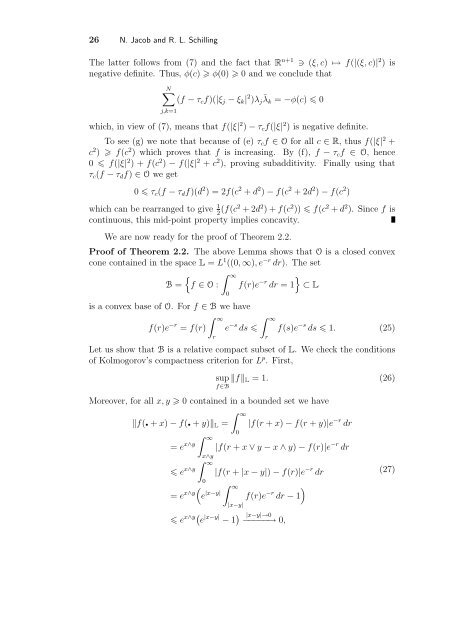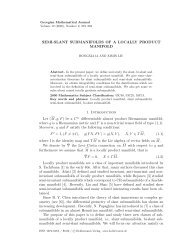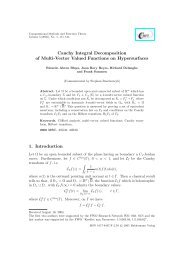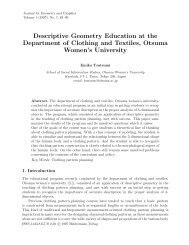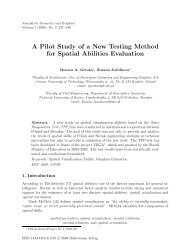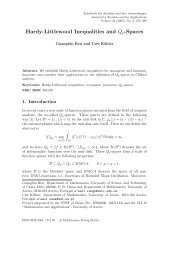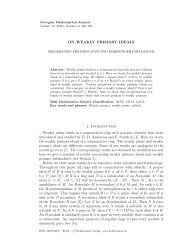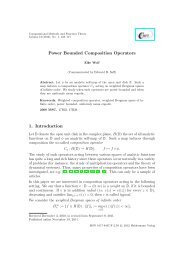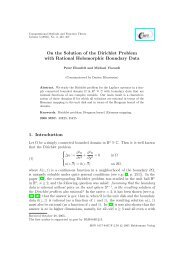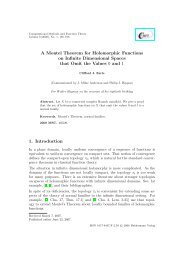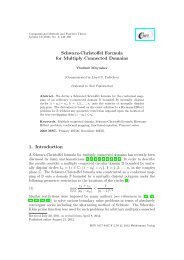Function Spaces as Dirichlet Spaces (About a Paper by Maz'ya and ...
Function Spaces as Dirichlet Spaces (About a Paper by Maz'ya and ...
Function Spaces as Dirichlet Spaces (About a Paper by Maz'ya and ...
Create successful ePaper yourself
Turn your PDF publications into a flip-book with our unique Google optimized e-Paper software.
26 N. Jacob <strong>and</strong> R. L. Schilling<br />
The latter follows from (7) <strong>and</strong> the fact that R n+1 ∋ (ξ, c) ↦→ f(|(ξ, c)| 2 ) is<br />
negative definite. Thus, φ(c) φ(0) 0 <strong>and</strong> we conclude that<br />
N∑<br />
(f − τ c f)(|ξ j − ξ k | 2 )λ j¯λk = −φ(c) 0<br />
j,k=1<br />
which, in view of (7), means that f(|ξ| 2 ) − τ c f(|ξ| 2 ) is negative definite.<br />
To see (g) we note that because of (e) τ c f ∈ O for all c ∈ R, thus f(|ξ| 2 +<br />
c 2 ) f(c 2 ) which proves that f is incre<strong>as</strong>ing. By (f), f − τ c f ∈ O, hence<br />
0 f(|ξ| 2 ) + f(c 2 ) − f(|ξ| 2 + c 2 ), proving subadditivity. Finally using that<br />
τ c (f − τ d f) ∈ O we get<br />
0 τ c (f − τ d f)(d 2 ) = 2f(c 2 + d 2 ) − f(c 2 + 2d 2 ) − f(c 2 )<br />
which can be rearranged to give 1 2 (f(c2 + 2d 2 ) + f(c 2 )) f(c 2 + d 2 ). Since f is<br />
continuous, this mid-point property implies concavity.<br />
We are now ready for the proof of Theorem 2.2.<br />
Proof of Theorem 2.2. The above Lemma shows that O is a closed convex<br />
cone contained in the space L = L 1 ((0, ∞), e −r dr). The set<br />
{ ∫ ∞<br />
}<br />
B = f ∈ O : f(r)e −r dr = 1 ⊂ L<br />
is a convex b<strong>as</strong>e of O. For f ∈ B we have<br />
f(r)e −r = f(r)<br />
∫ ∞<br />
r<br />
0<br />
e −s ds <br />
∫ ∞<br />
r<br />
f(s)e −s ds 1. (25)<br />
Let us show that B is a relative compact subset of L. We check the conditions<br />
of Kolmogorov’s compactness criterion for L p . First,<br />
sup ‖f‖ L = 1. (26)<br />
f∈B<br />
Moreover, for all x, y 0 contained in a bounded set we have<br />
‖f(• + x) − f(• + y)‖ L =<br />
∫ ∞<br />
0<br />
|f(r + x) − f(r + y)|e −r dr<br />
∫ ∞<br />
= e x∧y |f(r + x ∨ y − x ∧ y) − f(r)|e −r dr<br />
x∧y<br />
∫ ∞<br />
e x∧y |f(r + |x − y|) − f(r)|e −r dr<br />
0<br />
= e x∧y (<br />
e |x−y| ∫ ∞<br />
|x−y|<br />
)<br />
f(r)e −r dr − 1<br />
e x∧y( e |x−y| − 1 ) |x−y|→0<br />
−−−−−→ 0,<br />
(27)


